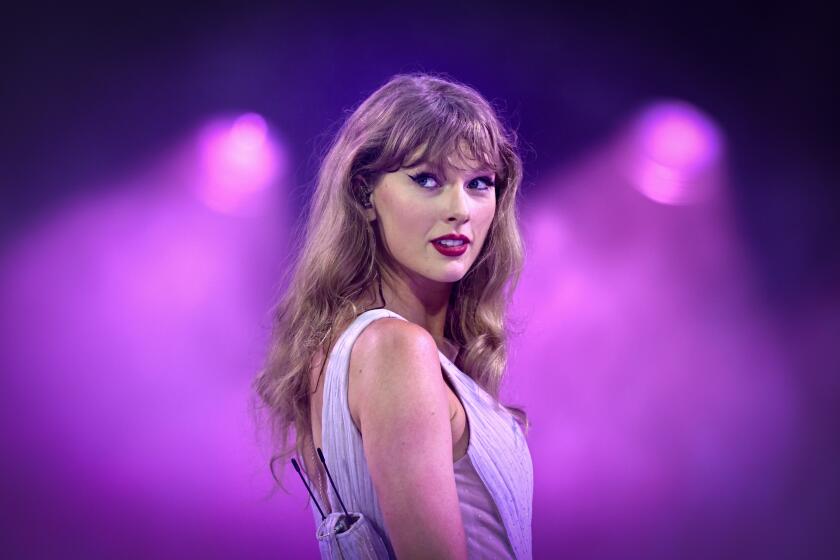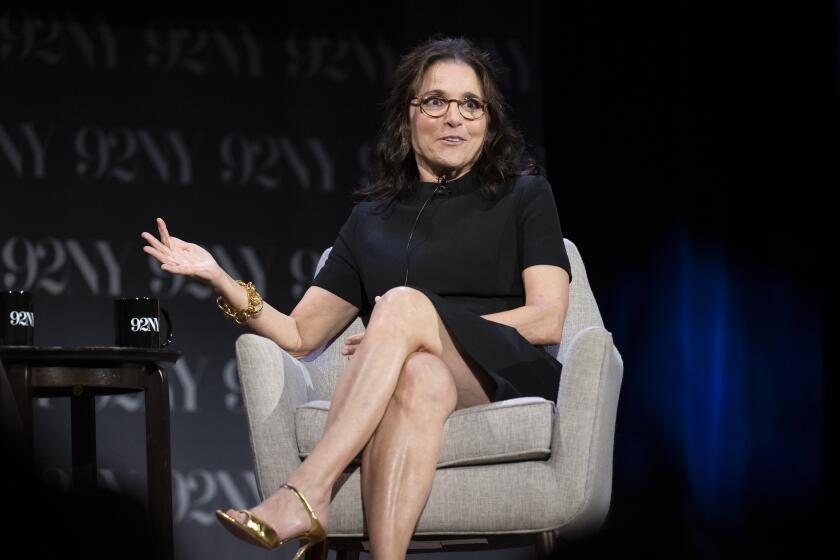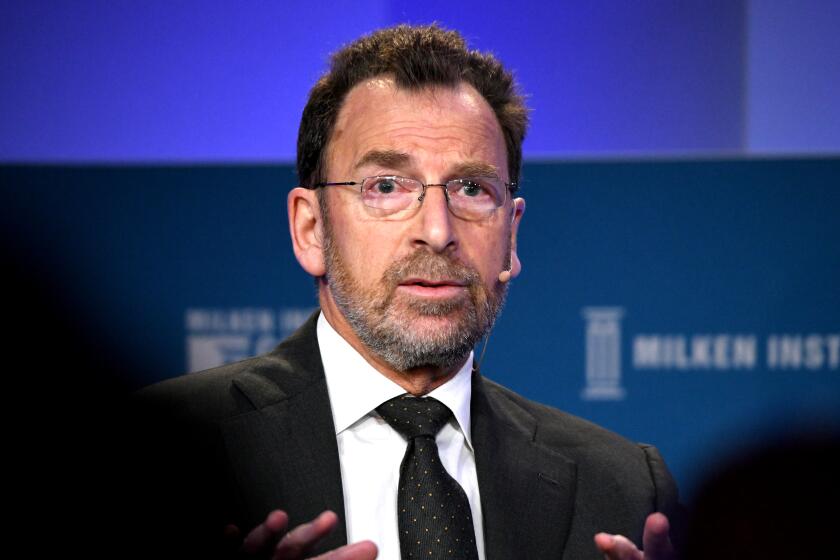The Players
It may have been the opening of a video arcade in Seattle, but it had Hollywood’s fingerprints all over it.
Televised nationally on MTV last weekend, it showcased media stars “Fresh Prince” Will Smith, Coolio and Beck astride the latest in video games, including one that ended with a gut-wrenching 24-foot free fall.
It was the kind of star firepower that only GameWorks, the $10-million brainchild of movie producer Steven Spielberg, could assemble. His DreamWorks SKG has teamed up with Sega Enterprises and Universal Studios, and plans to build 100 of the $10-million entertainment emporiums nationwide.
With its savvy blend of proprietary video games, designer pizzas and stylish architecture, GameWorks offers high-voltage proof that some of the biggest names in entertainment are now heading toward suburban malls and urban centers near your home.
Names like Disney, Spielberg, Sony--heavyweights with the business savvy and marketing might to dominate the theme park industry, produce Hollywood’s blockbusters and shape popular music--are looking for more.
Now they’re using their considerable clout to change the way that we play:
* Walt Disney Co., keeper of the Magic Kingdom that stretches from Anaheim to Tokyo, has spent millions on Club Disney, an upscale playsite in Thousand Oaks that’s the prototype for a proposed 100-unit chain.
* Earlier this month, Dave & Buster’s, a Dallas-based arcade chain geared toward adults, opened its premier California location at the massive Ontario Mills shopping center.
* Sony Corp. is readying a massive, four-story entertainment center in downtown San Francisco envisioned as the flagship for a string of major clubs to open in urban centers around the world.
* Ogden Corp., which operates venues such as the Great Western Forum, is breaking ground on a chain of mall-based storefronts that blend live animals and motion simulation machines to give suburbanites a wilderness experience. The billion-dollar company also is developing a dinner theater in Anaheim.
* Brunswick Corp., which makes everything from bowling balls to outboard motors, recently opened Red’s Rec Room at a massive mall in Alberta. The prototype that fills an old Ikea store is the possible precursor to a string of centers that incorporate a campy collection of bowling lanes, restaurants, bars and arcade games.
“We’re looking at things that a family can do for two or three hours after school and on weekends,” said Jay Rasulo, senior vice president of the new Disney Regional Entertainment division. “And, like Club Disney, the new concepts will be very different from Disneyland.”
Like the Disney Store chain, the playsites are designed to satisfy fanatics from places like Omaha, where a family trip to Disneyland means a $2,000 vacation.
But a day at the entertainment outposts also will be pricey. Disney charges an $8 admission--but that doesn’t include food and gifts. And that catered birthday for your child? Figure $250 for a dozen party-goers.
Even though GameWorks doesn’t charge an entry fee, competitors suspect that a family of five could easily spend more than $100 on games and meals.
The new playgrounds are wrapped up in typical Hollywood hyperbole. Disney promises to “set a new standard for local family entertainment,” while GameWorks pledges a “one-of-a-kind entertainment experience.”
Critics might scoff at the unbridled self-confidence, but there’s no denying that these companies are an elephantine force.
They know that Americans place a high level of trust in respected brand names. That’s why Mickey Mouse’s footprints are all over Club Disney and GameWorks is heralding its high-intensity game parlor as “Steven Spielberg’s three-ring circus.”
They also are crafting alliances with powerful brand names such as Starbucks and the Cheesecake Factory as they assemble one-stop centers where patrons can eat, drink, play and shop.
*
Despite the hoopla, these companies have reason to move carefully. Developers caution that entertainment could suffer the same fate as retailing, where consumers have been numbed by a string of look-alike shops in malls across America.
And, some big names have already stubbed their toes while trying to build nationwide chains that blend entertainment and dining.
Disney’s vaunted pixie dust proved ineffective during the early 1990s, when the company threw in the towel on Mickey’s Kitchen, a restaurant chain offering Meatless Mickey Burgers, Pinocchio Pizza and French fries shaped like Disney characters.
Six Flags has put Funtricity, the prototype for a string of entertainment centers, on hold, and Paramount Parks sold its interest in Block Party, another prototype angled toward adults.
Despite the potential barriers, developers sense that now is the time to strike. They’re playing to the fears of many consumers who think the world is spinning out of control.
“We’ve all watched what’s been happening in the [San Fernando] Valley with AK-47s,” said Michael McCall, a Columbia, Md.-based consultant who helped to design a funky bowling emporium for Brunswick Corp. “It’s sad but true. . . . We’re creating a community neighborhood where people feel safe, secure and can allow themselves to have fun.”
There’s no shortage of existing playgrounds. Americans already spend an estimated $8 billion annually on video games, jukeboxes and other token-grabbing machines found at 4,500 family entertainment centers and arcades.
Most of those mom-and-pop operators are adding video games and motion simulator rides to their proven arsenal of miniature golf, go-karts and batting cages. But few of them have the deep pockets and marketing know-how to tangle with the corporate army now on the march.
“When you put the corporate dollars that Sega has together with the creative mind of Steven Spielberg, you’re going to have a very high-profile, well-received arcade,” said Ed Pearson, general manager of a family fun center near GameWorks and president of the National Assn. of Family Fun Centers. “It’s a wake-up call for our industry.”
Smaller operators that fail to react run the risk of being steam-rolled by the powerful new players.
A case in point: Few mom-and-pop operations can afford more than a handful of the hot, Indy 500 video racing machines that retail for about $15,000. But with its deep pockets, GameWorks can plug in eight of them. And there are plans to hot-wire them to sister locations, clearing the way for truly nationwide competition.
GameWorks also will hone its competitive edge with proprietary attractions such as Vertical Reality, a Spielberg-inspired game where four players strap themselves into chairs that climb to a height of 24 feet--and plummet to the ground whenever weapon-wielding bad guys on a massive video screen score a direct hit.
*
Interactivity is the key word among the new concepts.
At most restaurants--even high-profile clubs such as Planet Hollywood and Hard Rock Cafe--”you eat and look,” McCall said. “What we wanted to create was a product where you did the theme.”
That’s why Red’s campy setting, which borrows heavily from your grandfather’s ‘50s-era basement recreation room, incorporates live entertainment, a children’s play area, billiard tables, arcade games and the funky “Furnace Room,” where patrons can puff expensive cigars and quaff aged scotch.
Anyone old enough to remember clubs where patrons used table-top telephones to talk with each other will get a chuckle out of the high-tech parallel at GameWorks, where guests chit-chat via computers.
Club Disney adds its own twist to interactivity. Since unchaperoned kids aren’t allowed, parents dance along with the Mickey Macarena, take part in a Disneyesque onstage play and sit down with their kids in the “Chat Hat,” a room filled with interactive media games.
But, don’t worry about running out of quarters: The new entertainment centers are borrowing a page from Dave & Buster’s, which offers an ATM-like debit card and plenty of convenient “power stations” where the cards can be recharged.
*
Soggy pizza and watered-down drinks might be fine for a 10-year-old’s birthday party, but not when you’re chasing upscale customers.
Michael Swinney, president of Sony Retail Development, readily acknowledges the glut of restaurants surrounding Sony’s downtown San Francisco entertainment center. But the entertainment center will add 10 more restaurants. Said Swinney: “We’ve got to be out of our minds.”
But there’s a method to the culinary madness: The longer you stay, the more you spend.
GameWorks players can sip Starbucks coffee drinks and wash down designer pizzas with suds from an on-site microbrewery. Club Disney offers kids their requisite pizza--albeit, shaped like Mickey Mouse--but it also offers upscale entrees from the Bristol Farms grocery chain, Cheesecake Factory desserts and Diedrich coffee drinks.
The intricate blend of entertainment and dining--dubbed “eatertainment” by restaurant industry wags--was pioneered by Dave & Buster’s.
Their 60,000-square-foot clubs in effect offer a working blueprint for what the big guys are trying to do.
The Ontario Mills club, for example, features hand-made billiard tables with mother-of-pearl inlays, the latest virtual reality games, Iwerks motion simulators and an ersatz casino.
Make no mistake: Dave & Buster’s knows where its profits come from. Half of a typical location’s $15 million in revenue is driven by electronic games that boast a 90% profit margin.
But chain spokesman Dennis Paine said that customers spend hours at Dave & Buster’s “because we’re serious about food and beverages. It’s not just a token thing.”
*
Real estate developers are clamoring for the new entertainment storefronts.
“I’d love to have [Club Disney] at a couple of our places,” said Irvine Co. Vice President Rick Evans. “Disney has consistently shown that it can produce a product that’s healthy and good. . . . This is a wonderful concept.”
Conventional wisdom suggests that Disney’s success with the Disney Store chain--which grew to 500 locations in less than a decade--bodes well for the entertainment giants as they move into neighborhood locations.
Randall Hiatt, president of Fessell International, an Irvine-based consulting firm, figures that Disney could easily find 500 locations for various entertainment concepts that the company is now developing.
“Say they go into five or six entertainment centers and malls in Orange County,” Hiatt said, “and all of a sudden Disney is doing another $30 million in business.”
That promise of gold at the end of the rainbow is what’s driving the surge in entertainment-oriented concepts.
The owner of Pier 39 in San Francisco is developing a miniature version of an aquatic park that could be dropped down into shopping centers, Imax is shrinking its big screens to fit into smaller malls and Simon Debartolo Group Co-Chairman Mel Simon promises a $30-million “one-of-a-kind” arcade in Las Vegas.
Big entertainment companies with proven stars like Mickey Mouse are shamelessly using their cultural images to draw consumers. And companies without obvious star appeal are combing their assets, looking for potential hooks.
Sony has licensed characters from author Maurice Sendak’s popular books, and a hands-on science center at its San Francisco entertainment center will incorporate concepts from “The Way Things Work,” David MacCauley’s book.
Warner Brothers recently suggested that several Time-Warner operations--including Sports Illustrated, CNN and People Magazine--are being studied for ‘potential food service and retail concepts.”
*
If history is any guide, some of the projects will die untimely deaths.
Tarun Kapoor, a hospitality industry professor at Cal Poly Pomona, cautions that the new, neighborhood-based attractions will need continual face-lifts--a potentially expensive process given the ever-changing tastes of fickle consumers.
And, during a recent Urban Land Institute program at the Beverly Hills Hilton, the developer of the Pier 39 park cautioned gung-ho developers about the potential for failure.
“There are a lot of opportunities out there to make mistakes,” said Robert Moor, a partner with Lake Forest, Ill.-based Moor & South. “And if the money is there, mistakes will be made.”
(BEGIN TEXT OF INFOBOX / INFOGRAPHIC)
Make Way for Mega-Entertainment
Cavernous indoor play centers offering an array of attractions for children and adults are the latest in family entertainment. Some Southland concepts and locations:
Club Disney
Owner: Walt Disney Co.
Location: Thousand Oaks
Admission: $8 per person
Features: Playground, maze, multimedia room, film studio, arts and crafts center, restaurant, retail shop and birthday party rooms
Square feet: 24,500
Opened: Feb. 21, 1997
Expansion plans: 100-location chain
****
Dave & Buster’s
Owner: Dave & Buster’s Inc.
Location: Ontario, Calif.
Admission: None; customers may purchase debit card for use in game machines and other attractions
Features: Play-for-fun casino, midway games, electronic simulators, billiards, shuffleboard, murder-mystery dinner theater, banquet and seminar rooms, golf simulator, snack bar, restaurant, bar with 20-screen video dome
Square feet: 60,000
Opened: Mar. 13, 1997
Locations: 10, with at least five more scheduled to open in 1997-1998
Elsewhere on the West Coast:
****
Sony Entertainment Center
Owner: Sony Retail Entertainment
Location: San Francisco
Admission: To be determined
Features: 15-screen theater complex, 3-D Sony IMAX theater, children’s play areas, retail stores, restaurant, learning and educational attractions, sci-fi electronic play technology, live musical performances
Square feet: 350,000
Opening: Fall 1998
Expansion plans: Chain of clubs in urban centers worldwide
****
GameWorks
Owners: Steven Spielberg, DreamWorks, Sega Enterprises and Universal Studios
Location: Seattle
Admission: None; customers may purchase debit card for use in game machines and other attractions.
Features: Virtual reality simulators, music videos, Starbucks coffee, gourmet pizza, brew pub, Internet lounge, pinball, air hockey, arcade games
Square feet: 30,000
Opened: March 15, 1997
Expansion plans: 40 locations by 2002
Source: Individual companies
Researched by JANICE L. JONES / Los Angeles Times
More to Read
The biggest entertainment stories
Get our big stories about Hollywood, film, television, music, arts, culture and more right in your inbox as soon as they publish.
You may occasionally receive promotional content from the Los Angeles Times.






